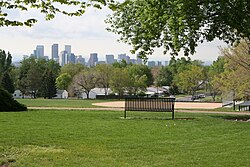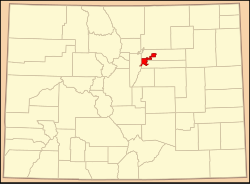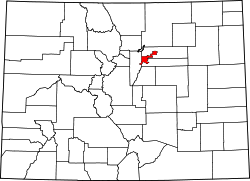Zuni Park
Zuni Park is located at the northern edge of Chaffee Park Neighborhood between Zuni Street and Vallejo Street, south of West 52nd Avenue. [25] Zuni Park features: a bike/pedestrian path, multiple picnic areas, a drinking fountain, restrooms, shelter, a basketball court, a playground, mixed-use field space, a baseball/softball field, and an outdoor fitness equipment area (one of The Trust for Public Land's Fitness Zone® program areas). The Fitness Zone was developed as a part of a partnership between nearby Regis University and The Trust for Public Land, who installed the equipment in March 2016 in coordination with Denver Parks and Recreation. [26] [27]
Zuni Park is technically unnamed and referred to as 51st & Zuni Park by the Denver Parks and Recreation Department, however it is colloquially known as Zuni Park. [28]
Beach Court Elementary
Beach Court Elementary originally opened in 1921 at West 46th Avenue and Alcott Street utilizing three temporary structures, a fourth was added in 1927 however all four temporary buildings were taken down and replaced with a permanent building in 1929. [29] In its first iteration, the school featured three bungalows and one kindergarten room serving approximately 100 students. [30] Rapid enrollment at the school led to the design and construction of a new building at West 46th Avenue and Beach Court in 1929–30, designed by architect G. Meredith Musick, with six classrooms and one kindergarten. [31]
The neighborhood experienced continued growth and Musick oversaw an addition to the school in 1949–51, dedicated on May 21, 1951. At the time of the addition, approximately 600 students attended Beach Court Elementary. [32] In 1951 the school grew to seven classrooms and two kindergarten rooms. Additional facilities were added, including the: library, gymnasium, kitchen, clinic, conference room, office, and teacher's lounge. Educational programming expanded to include audio-visual aids, health programs, film and movie equipment, a band, and orchestra lessons. The school also functioned as a community center, used by organizations like the Boy Scouts, Girl Scouts, and the Red Cross, for sewing, first aid, nutrition, and other classes. [33]
The school grew to twenty-two classrooms in 1993, with an addition designed by architecture firm JH/P Architecture and built by Ward Construction. The school also moved to a student-centered environment with the State of Colorado's student performance standards. [34] [35]
In October 2016 Beach Court Elementary was among the first Denver Public Schools (DPS) to receive a SmartLab, after a competitive application process. This addition to the schools' educational offerings was made possible by a donation from DPS alumni Marco Campus, with the remaining half of matching funds coming from DPS and the DPS Foundation. [36] [37] SmartLabs offer project-based, student-centered curriculum supporting STEM and other core academic content. SmartLabs are a part of DPS CareerConnect's STEMConnect partnership with DPS Curriculum and Instruction with the aim of getting students interested in STEM careers at an early age. [38]
Beach Court Elementary's school colors are blue and white and their mascot is the eagle. [34]
Zuni Plaza
Zuni Plaza is an upcoming development in the heart of Chaffee Park (49th Avenue and Zuni Street) at a vacant church originally built in 1952. The project is converting the building and parking area into a commercial space for retail, restaurants, and a dedicated artist studio within the former church building. While Chaffee Park grew after the city's streetcar system connecting north Denver was dismantled, Zuni Plaza will serve as an extension of the revitalized former streetcar commercial nodes spanning north Denver along Zuni Street (which connects the Chaffee Park, Sunnyside, Highland, and Jefferson Park neighborhoods). The Zuni Plaza project is led by Denver-based developers Columbia Group and Paul Tamburello (founder of Little Man Ice Cream in LoHi and dubbed the "father of the rejuvenated Highland" by The Denver Post.) [41] [42]



